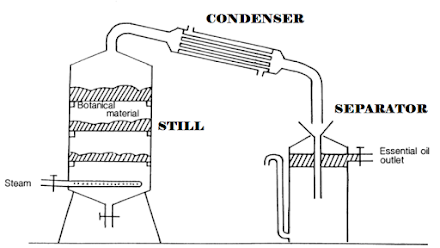Essential oils are the collection of hydrophobic secondary metabolites that can be extracted from plants and are used in perfumes, flavorings and alternative medicine techniques such as aromatherapy.
Steam distillation is known to be the most prevalent method of essential oil extraction. The steam is normally generated in a separate boiler and then blown through the botanical material in a still, thus softening the cells and letting the essential oil escape in vaporized form.
The fundamental nature of the process behind the distillation of two heterogenous liquids, such as water and an essential oil, is that each other exerts its own vapor pressure as if the other component were absent.
When combined vapor pressures equal the surrounding pressure, the mixture will boil. Essential oil component, with boiling points normally ranging up to 300° C will thus evaporated.
The steam and essential oil then condensed and separated. Steam distillation of biomass generally yields two products: a relatively high purity essential oil and an aqueous condensate called a hydrosol. The oil consists of hydrophobic, often aromatic compounds that are produced in very small concentrations as secondary metabolites in the plants. The hydrosol also contains secondary metabolites but these compounds are more hydrophilic.
Extraction of essential oil by steam distillation
The Evolution of Modern Food Flavor
-
The evolution of modern food flavor is a story shaped by scientific
curiosity, technological progress, and the growing demands of an
industrialized world. ...




